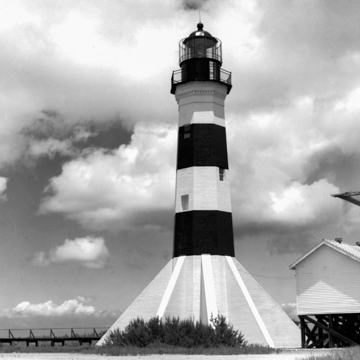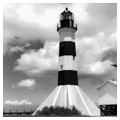Located near the mouth of the Sabine River, which divides Louisiana from Texas, this abandoned brick lighthouse with its splayed base, designed by U.S. Army engineer Captain Danville Leadbetter (1811–1866), looks like a rocket ship about to launch. To avoid the fate of other brick lighthouses along Louisiana’s coast that sank because they were too heavy for the soft, marshy soil, Leadbetter gave the base of this octagonal structure eight finlike buttresses (four of them reaching 18 feet at the base, the other four 10 feet) in order to distribute the structure’s weight. Standing on a foundation of wooden piles, brick, and shellcrete (a mixture of oyster shells and aggregate or clay), the lighthouse reaches a height of 85 feet and has 18-inch-thick brick walls. At its top is a brick cornice ornamented with dentils and a cylindrical lantern room, originally covered by a copper dome. A walkway with a metal railing surrounded the lantern, which allowed the keeper to clean the glass. In addition to being an impressive feat of engineering, the lighthouse is a fine work of architecture. Its strong base (the fins), the smooth column-like shape, and the concluding dentils and moldings lend the structure a Greek Revival flavor. This aesthetic was not by chance, for it was built in an era when engineering projects were conceived as civic monuments.
Inside the lighthouse, a cast-iron spiral staircase rises to the lantern. Initially, the light consisted of an oil lamp with reflectors, but this was later replaced by a third-order Fresnel lens. The lantern's beam was visible for a distance of twenty-five miles, helping ships from the Gulf of Mexico to navigate Sabine Pass and enter the river. During the Civil War, the light was extinguished to prevent Union boats from finding their way up the Sabine River, and a sunken Union gunboat rests in the riverbed nearby. Modern navigational systems have made many lighthouses redundant, and this one was decommissioned in 1952.
Leadbetter used the same plans for three other lighthouses; the two in Louisiana have been demolished, but the remaining example, at Aransas Pass, Texas, still stands. He also supervised fort construction during his career with the army. After resigning from the army in 1857, Leadbetter spent the remainder of his years in Mexico, also designing lighthouses.













